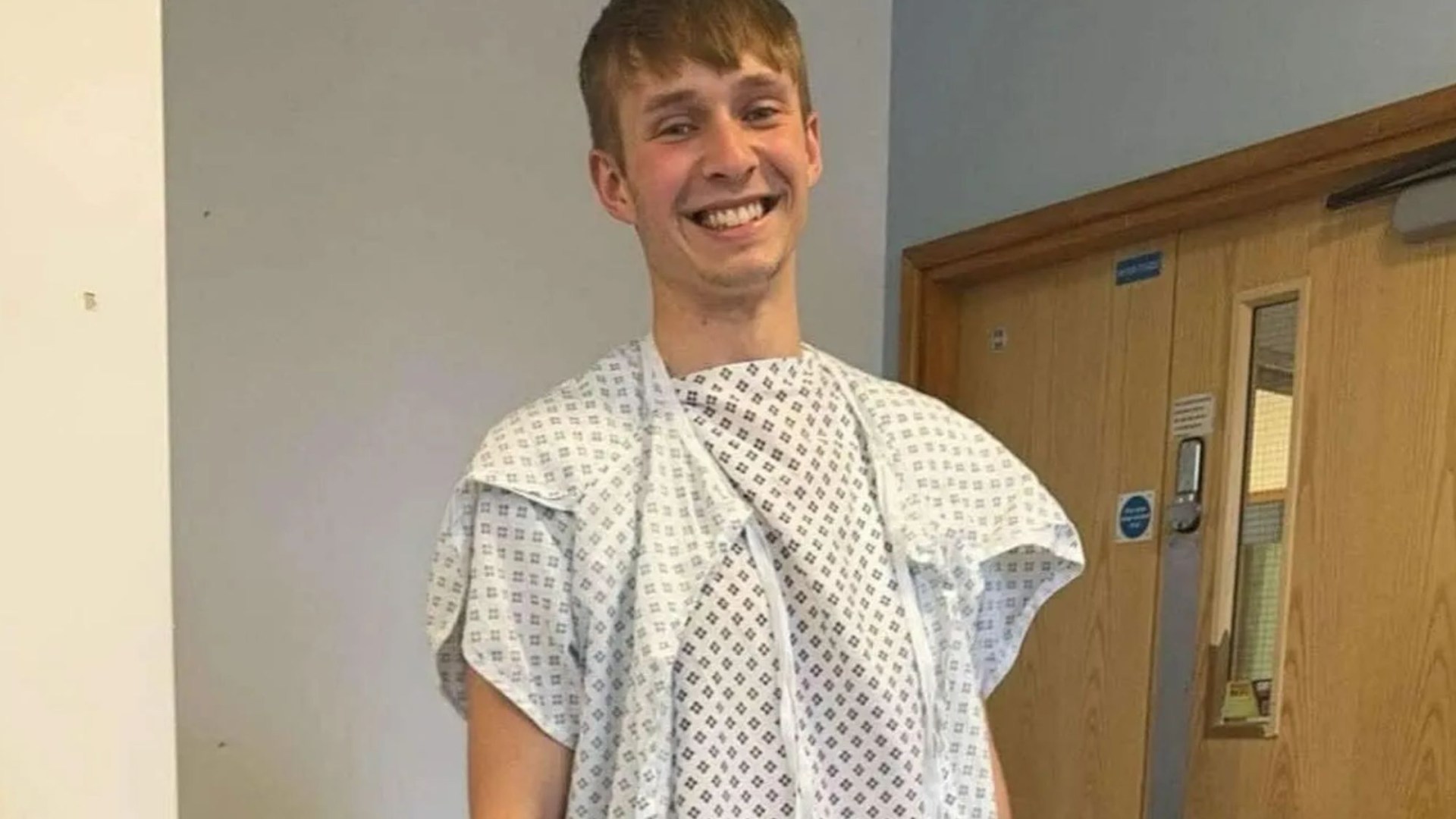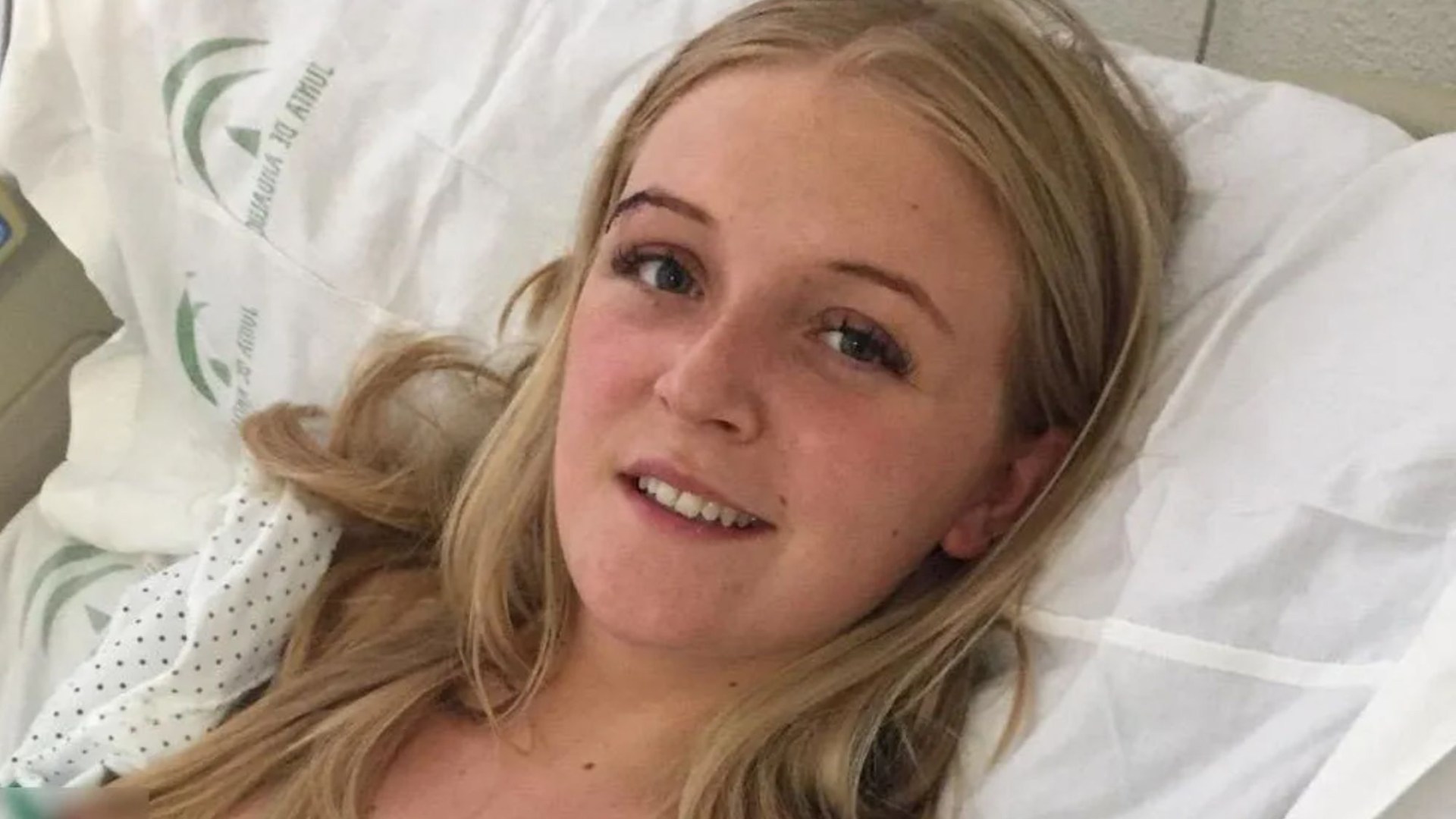Health & fitness
Man, 26, discovers he has cancer after accidentally biting his tongue while sneezing

A MAN says biting down on his tongue while sneezing saved his life – after it lead to the discovery that he had cancer.
Dan Durant, 26, first noticed an ulcer on the right side of his tongue in summer last year but didn’t think anything of it.
But when Dan accidentally bit his tongue while sneezing “really hard”, the lump became inflamed and he went to the doctor.
He was shocked when he was diagnosed with squamous cell carcinoma – a type of cancer – and told it was aggressive and he needed to have surgery to remove the tumour.
In the 11-hour operation, doctors removed 50 per cent of Dan’s tongue to cut out the two tumours they found and reconstructed it using skin from his left forearm.
They also dissected his neck to check the cancer hadn’t spread to his lymph nodes.
Read more on mouth cancer
Dan is currently waiting for the results from the biopsy, which will confirm if he needs to have any following treatment.
Dan, who was working as a supervisor at a bar, from Stafford, Staffordshire, said: “I sneezed really hard and ended up biting my tongue.
“It went really inflamed.
“I was directed to Stoke Hospital and told it was cancer and it was aggressive.
“I had around 50 per cent of my tongue removed and reconstructed.
“The nurse said ‘you were lucky you bit your tongue’.”
Dan often got ulcers so didn’t think anything of the lump on his tongue when he first spotted it in August 2023.
He treated it with Bonjela and stopped noticing it. He also lost a lot of weight and often had a sore throat but didn’t realise it was anything to be worried about.
Dan said: “It was a grey, whitish patch. It was the size of a one pence coin.
“I didn’t think of it after that.
“Mostly it just felt like it wasn’t there.”
But Dan started to notice the ulcer again in April 2024 and it became inflamed in August when he accidentally bit down on it.
He went to see his doctor who was suspicious it was cancerous and redirected him to Royal Stoke University Hospital, Stoke-on-Trent.
Dan’s cancer diagnosis was confirmed a week later on August 21, 2024.
He said: “I didn’t quite believe it could be cancer.
“Being told it was upsetting. I did have a cry.
“It was so surreal.”
GRUELLING OP
Dan was told the cancer was aggressive and they needed to get him into surgery soon to remove the tumour.
On September 12, 2024 Dan had the 11-and-a-half hour operation.
Doctors had planned to do a partial removal of his tongue but had to remove 50 per cent when they found a second tumour.
At the same time the took a lymph node from his neck to do a biopsy – to confirm the cancer had not spread.
Signs of disease in the mouth
BAD breath and mouth ulcers are common occurrences.
But they may signal an underlying health problem, too.
Dr Rahul Nehra, Lead Dentist at The Smile Gallery, warns of the symptoms in your mouth that should never be ignored.
BLEEDING GUMS
PERSISTENT bleeding gums, especially during brushing or flossing, can indicate gum disease, such as gingivitis or periodontitis.
This is often caused by plaque buildup along the gumline, leading to inflammation and potential tissue damage.
It’s essential to address bleeding gums promptly to prevent further complications like gum recession and tooth loss.
For bleeding gums, proper oral hygiene is crucial, along with professional dental cleanings to remove plaque and tartar buildup.
BAD BREATH
Chronic bad breath, or halitosis, can be a sign of various dental issues, including poor oral hygiene, gum disease or cavities.
But it could be an underlying health problem such as diabetes or gastrointestinal issues.
Dental check-ups can help identify and address the root cause of bad breath, such as gum disease.
Improving bad breath typically involves maintaining good oral hygiene habits, such as brushing twice daily, flossing, and using an antimicrobial mouthwash.
LUMPS AND SORES
WHILE occasional mouth sores are common and often harmless, persistent lumps or sores that don’t heal within two weeks could be signs of more serious conditions such as oral cancer.
Other concerning signs include white or red patches, numbness, or difficulty moving the jaw. If you notice any of these symptoms, seeing a dentist or doctor for further evaluation is crucial.
Sores in the mouth may benefit from topical treatments or medications prescribed by a dentist or doctor, while monitoring for any signs of infection or malignancy.
WOBBLY TEETH
LOOSE teeth can indicate advanced gum disease or untreated tooth decay.
Without prompt intervention, this can lead to tooth loss and bone deterioration.
Seeking dental care as soon as possible can help preserve remaining teeth, possibly through procedures like scaling and root planing or dental restorations.
SWALLOWING DIFFICULTY
DIFFICULTY swallowing, also known as dysphagia, can be caused by various factors, including oral infections, inflamed tonsils, or even more severe issues like throat cancer.
If you experience persistent difficulty swallowing or a sensation of something stuck in your throat, it’s essential to seek medical or dental attention promptly for evaluation and appropriate treatment.
CROAKY VOICE
A CROAKY or hoarse voice can result from various conditions affecting the throat or vocal cords, including acid reflux, respiratory infections, or vocal cord nodules or polyps.
In some cases, poor oral hygiene or throat irritation can also contribute to voice changes.
If you experience persistent hoarseness or voice changes, it’s advisable to consult with a healthcare professional.
Addressing a croaky voice may involve lifestyle modifications, such as avoiding irritants like tobacco smoke or excessive vocal strain.
He said: “They took skin from my forearm for my tongue and then the skin from my stomach to replace skin on my arm.
“They also used my the arteries from my forearm and put them into my tongue so there was a blood flow.”
Dan then spent eight days in hospital – to ensure there were no problems following the reconstruction and so he could get used to eating and drinking again.
‘LIFE-CHANGING’
The 26-year-old is now on a soft food diet and is waiting for his results from the biopsy on his lymph node.
Dan said: “Learning to swallow properly was quite difficult.
“I’m just getting used to chewing.
“My jaw aches a lot. It’s a lot of relearning things.
“If there is little to no cancer cells left I will just be one round of radiotherapy.”
Signs of mouth cancer
Symptoms of mouth cancer:
- ulcers that don’t heal
- pain in your mouth
- red or white patches in your mouth or throat
- a persistent sore throat
- having pain or difficulty swallowing
- speech problems
- a lump in your neck
- weight loss
- bad breath
If you have any of these symptoms you must get them checked by your GP or dentist.
But remember, they can all be caused by other conditions.
Most people with these symptoms don’t have mouth and oropharyngeal cancer.
Source: Cancer Research UK
Dan was about to start a new job when he got his diagnosis and is now unable to work.
As well as raising awareness, Dan has set up a fundraiser to help fund his living costs for the next few months and will donate any remaining money to cancer research.
He said his family and friends have been a “wonderful supportive network”.
Dan said: “Everything is normal and then all of a sudden it is not.
“It’s a life-changing thing.”
Womens Workouts
1000 Calorie Workout – Total Body Weight Loss

Want to know how you can burn as much as 1000 calories in one session alone? Here is another 1-hr workout just for you!!
This intensive weight loss workout is an amazing workout that you can do at home to burn fat and strengthen your muscles. This workout is meant to target and burn your fat, even the underlying fat, with continuous workouts.
You can do this workout at least 3-4x a week for the best results. I don’t recommend this to be done everyday but if you can manage to do it, why not! Good luck and let’s get moving!❤️💪
**If you want to be notified when I upload a new video, make sure to subscribe to our channel. I upload new videos everyday from Sunday to Friday!
source
Health & fitness
Breakthrough cancer treatment ‘could be the cure’ after making ‘death sentence’ tumours ‘disappear’

A BREAKTHROUGH cancer treatment “could be the cure” for a “death sentence” form of the disease after making tumours disappear.
The experimental approach has seen remarkable success in some brain cancer patients – with experts saying it could be available on the NHS within five years.
Over 12,000 people are diagnosed with brain tumours every year in the UK.
But just one in 10 patients are alive a decade after their diagnosis, according to Cancer Research UK.
Prognosis tends to be bleak due to how fast brain cancer spreads, as well as a lack of treatments able to successfully combat it.
But a new treatment plan that combines the drug ipilimumab with surgery, chemotherapy, or radiotherapy, could be a game-changer for many sufferers.
Read more on brain tumours
Ipilimumab – an immunotherapy drug given as a drip into the bloodstream that’s already used on the NHS to treat skin cancer – is first administered to shrink the tumour.
Experts behind the treatment say the drug helps patients’ own immune systems to seek out and destroy cancerous cells.
Patients are then offered surgery to remove what’s left of the tumour, or chemo and radiotherapy – in some cases both.
So far, only a handful of patients have been offered the innovative new treatment protocol pioneered by Dr Paul Mulholland, a brain cancer specialist at University College London (UCL).
Businesswoman Sara Sjölund became one of them after being diagnosed with brain cancer in 2018 at the age of 38, Mail Online reported.
Sara underwent radiotherapy, chemotherapy and surgery in an effort to halt the spread of her astrocytoma tumour, to no avail.
Running out of options by the middle of 2023, Sara was offered the chance to trial the novel brain cancer treatment plan.
After six months on ipilimumab, Sara’s tumour is “inactive”, according to Dr Mulholland.
“Sara’s scans show remnants of the tumour. As long as it stays as it is she will be fine,” he said.
Sara described it in this way: “Like a dead tree, it is still there but at the moment it does not look like it will regrow.”
It’s too early to know the outcome of the businesswoman’s treatment, but Sara feels like she’s “been given [her] life back”.
She’s not the first to be offered – and see success from – the breakthrough treatment.
Ben Trotman, 41, who brought forward his own wedding after getting a shock glioblastoma diagnosis and being given “months to live” was left virtually disease-free after being enrolled in a world-first clinical trial for the treatment.
After “grappling with the fact he had gone from being apparently perfectly healthy to having months to live”, Ben saw his tumour recede in a way that was “previously unheard of”.
Cancer experts have suggested that the immunotherapy drug could in fact become a cure for brain cancer.
Dr Mathew Clement, from the Cancer Research Centre in Wales, told MailOnline: “It is not out of the question that it could be a cure.
“We know ipilimumab is effective for other cancers and we have shown that we can apply them to treat brain tumours.
“We could see this treatment offered on the NHS within five years.”
The same treatment programme was also used successfully by Prof Richard Scolyer, who was diagnosed with incurable grade 4 glioblastoma cancer after suffering a seizure last year.
‘WORK IN PROGRESS’
Brain cancer is particularly difficult to treat as many drugs can’t bypass the blood brain barrier – a protective wall of cells that acts as a filter and protects the brain from harmful substances and germs in the blood that could cause damage.
But immunotherapy drugs such as ipilimumab don’t encounter this issue, Dr Mulholland said, as they instead work by helping the body’s immune system T-cells to spot and attack tumours.
Researchers are planning an upcoming clinical trial that will focus on offering the drug as early as possible after patients are diagnosed.
While Sara only received the drug after standard treatment had failed, both Ben and Professor Scolyer were able to use it straight after diagnosis – leading their tumours to disappear.
The most common symptoms of a brain tumour

More than 12,000 Brits are diagnosed with a primary brain tumour every year — of which around half are cancerous — with 5,300 losing their lives.
The disease is the most deadly cancer in children and adults aged under 40, according to the Brain Tumour Charity.
Brain tumours reduce life expectancies by an average of 27 years, with just 12 per cent of adults surviving five years after diagnosis.
There are two main types, with non-cancerous benign tumours growing more slowly and being less likely to return after treatment.
Cancerous malignant brain tumours can either start in the brain or spread there from elsewhere in the body and are more likely to return.
Brain tumours can cause headaches, seizures, nausea, vomiting and memory problems, according to the NHS.
They can also lead to changes in personality weakness or paralysis on one side of the problem and problems with speech or vision.
The nine most common symptoms are:
- Headaches
- Seizures
- Feeling sick
- Being sick
- Memory problems
- Change in personality
- Weakness or paralysis on one side of the body
- Vision problems
- Speech problems
If you are suffering any of these symptoms, particularly a headache that feels different from the ones you normally get, you should visit your GP.
Source: NHS
As such, giving patients ipilimumab as early as possible may be the key to curing brain cancer, Dr Mulholland claimed.
“What we want to do is get patients early on in the disease before the body is weakened by chemotherapy and radiotherapy,” he said.
“Essentially we’re saying, let’s protect the immune system so it has the best shot at fighting the cancer.”
Other experts have urged caution on touting the success of the treatment plan, as it’s only been used on a handful of patients.
Dr Matthew Williams, a clinical oncologist at Imperial College London, told MailOnline that we can’t at present know if the drugs could be rolled out at a large scale to treat brain cancer.
“There are exciting developments but it is very much a work in progress at this stage,” he stated.
It is hoped that the clinical trial set to start next year will provide the data required to see the treatment rolled out on the NHS.
Womens Workouts
#brain #exercise
Health & fitness
Girl, 17, woke up paralysed after contraceptive pill caused blood clot to pass through a hole in her heart to her brain

A TEENAGE girl was on a family holiday in Spain when she experienced the terrifying symptoms of a blood clot.
Lauren Jean, 17, woke up one night to find the entire right side of her body was numb.
She tried to get out of bed but fell, which alerted her parents.
As she was unable to speak or move, they decided to call an ambulance.
Lauren was airlifted to Hospital Universitario Torrecardenas in Almeria for emergency surgery, which revealed she had developed a blood clot that had travelled to her brain and caused a stroke.
Doctors told her the clot was caused by her combined contraceptive pill.
Scans later showed the teen had been born with a hole in her heart, which the clot had passed through and up to her head.
The stroke left Lauren unable to walk or talk, and she spent months having physiotherapy to regain those functions.
She also had a surgery to repair the hole in her heart.
But two years on, she’s unrecognisable, and training for the 2025 London Marathon.
Lauren, now 20, from Clitheroe, Lancashire, said: “On the day I had my stroke, my parents were told the chances of me surviving were slim to none.
“I remember I couldn’t move or speak and I was being wheeled into emergency surgery. I had no idea what was going on.
“When I found out it was because I developed a blood clot and had a heart defect, I thought my life would never be the same again.
“After my surgeries I had to learn how to walk again – it was hard but they couldn’t stop me trying.”
Lauren didn’t want to sit down until she could walk again, and she then applied for the London Marathon.
“Now I’m training and stronger than I was before – you’d never know I had a stroke two years ago,” she said.
The singer-songwriter had been taking the combined contraceptive pill since the age of 13 to control heavy periods.
She was aware of the slight risks of blood clots associated with the pill, but never imagined it would affect her.
That was until August 12, 2022, while on holiday with her family in Mojacar, Spain, when the blood clot woke her up in the night.
When I was told I’d had a stroke I couldn’t believe it. I said, ‘What? Do you mean sunstroke?’
Lauren Jean
“I kept blacking out and I couldn’t ask any questions, I feared for my life,” Lauren said.
“I was wheeled into a room full of people for surgery, I couldn’t ask what surgery I was having though.
“It could have been brain surgery, heart surgery or to chop my leg off for all I knew.”
She underwent brain surgery lasting several hours where doctors found a blood clot which had caused her stroke.
Lauren said: “When I was told I’d had a stroke I couldn’t believe it. I said, ‘What? Do you mean sunstroke?’”
After days on the intensive care ward, unable to walk, talk, or even use the toilet on her own, she was taken for a heart scan, where doctors spotted a hole in her heart, called a patent foramen ovale.
Lauren begged to fly back to the UK before having further treatment.
Once home, doctors explained the reason for her blood clot had been her contraceptive pill.
ROAD TO RECOVERY
She said: “They told me the clot would have started in my leg, and normally it would have disintegrated on its own.
“But because I have this hole in my heart, it had slipped through and gone into my brain, causing my stroke.”
She began a physiotherapy course at Royal Blackburn Hospital to regain movement, and it took her six weeks to walk again.
In July 2023, she had heart surgery where a device was implanted to close the hole, after which she decided she wanted to take on a challenge – the London Marathon.
Lauren has been hitting the gym six days a week and has been running 40km a week to train.
She said: “I’m still training my right side to be stronger but I’m back to my normal self.
“Apart from being left with a twitch in my finger, you’d never know I nearly died.
“I couldn’t play piano, guitar or sing after, but I’m getting it back and I have started performing again.”
Contraceptive pill benefits and risks
BENEFITS:
Pregnancy prevention – the pill is over 99 per cent effective if used correctly every time.
Menstrual health – the pill can make periods lighter, less painful, and more regular.
Acne – the pill can help with acne.
Cancer risk – the pill can reduce the risk of ovarian, endometrial and colon cancer.
Other health benefits – it can also help with symptoms of premenstrual syndrome (PMS), endometriosis, and polycystic ovary syndrome (PCOS).
RISKS:
Side effects – the pill can cause temporary side effects, such as headaches, nausea, breast tenderness, mood changes, and increased blood pressure.
Bleeding – breakthrough bleeding or changes to your period are common in the first few months.
Serious health conditions – the pill has been linked to an increased risk of some serious health conditions, such as blood clots and breast cancer.
No protection against STIs – the pill doesn’t protect you against sexually transmitted infections.
Source: NHS
Lauren also hopes to raise awareness of strokes in young people.
She said: “I had severe headaches and tingling on one side of my body before my stroke.
“Get any symptoms checked out.
“When I was told I had a stroke, I thought, ‘Surely not, I’m only 17’.
“I kept saying to my mum, ‘This can’t be right’.
“I always thought it wouldn’t happen to me, but it can. Strokes can affect anyone.”
Womens Workouts
30-MIN FULL BODY WORKOUT: NO JUMP, NO LUNGE, NO REPEAT

Here is another highly requested workout you can do at home that will help you lose weight much easier — no jumping, no lunges!
This is a fun albeit intensive workout that you can do at home to burn fat and lose weight!
The doable routines included in this workout will help you achieve the best results as you regularly do the workout.
Good luck and let’s get moving!❤️💪
TIMECODES:
00:00 Introduction
00:16 Lateral Arm Circles
01:08 Rest
01:30 Forward Calf Raises
02:26 Rest
02:48 Knee Drive
03:46 Rest
04:08 Side Leg Raise Left
04:42 Side Leg Raise Right
05:16 Rest
05:38 Punches
06:31 Rest
06:53 Step Back Jacks
07:48 Rest
08:30 Body Extensions
09:24 Rest
09:46 Deadlifts
10:45 Rest
11:07 Leg Kicks
12:02 Rest
12:24 Waist Pinchers Left
12:57 Waist Pinchers Right
13:30 Rest
13:52 Chest Fly
14:46 Rest
15:08 Lateral Taps
16:03 Rest
16:46 Bird Dog
17:43 Rest
18:05 Bridge
19:03 Rest
19:25 Donkey Kicks Left
19:59 Donkey Kicks Right
20:32 Rest
20:54 Fire Hydrant Left
21:28 Fire Hydrant Right
22:01 Rest
22:23 Leg Pulls
23:16 Rest
23:38 Bicycle Crunches
24:31 Rest
25:13 Slow Mountain Climber
26:08 Rest
26:30 Plank Press Back
27:23 Rest
27:45 Knee Tuck Crunch
28:40 Rest
29:02 Swimmers
29:57 Rest
30:19 Thigh Lifts Left
30:51 Thigh Lifts Right
31:22 Rest
31:44 Toe Touches
source
Womens Workouts
Freedom is being you, without anyone s permission. Fitness workout routine
-

 Science & Environment4 weeks ago
Science & Environment4 weeks agoHyperelastic gel is one of the stretchiest materials known to science
-

 Technology4 weeks ago
Technology4 weeks agoWould-be reality TV contestants ‘not looking real’
-

 Science & Environment4 weeks ago
Science & Environment4 weeks agoHow to unsnarl a tangle of threads, according to physics
-

 Science & Environment4 weeks ago
Science & Environment4 weeks ago‘Running of the bulls’ festival crowds move like charged particles
-

 Science & Environment4 weeks ago
Science & Environment4 weeks agoMaxwell’s demon charges quantum batteries inside of a quantum computer
-

 Science & Environment4 weeks ago
Science & Environment4 weeks agoLiquid crystals could improve quantum communication devices
-

 Womens Workouts3 weeks ago
Womens Workouts3 weeks ago3 Day Full Body Women’s Dumbbell Only Workout
-

 Science & Environment4 weeks ago
Science & Environment4 weeks agoQuantum ‘supersolid’ matter stirred using magnets
-

 Technology3 weeks ago
Technology3 weeks agoIs sharing your smartphone PIN part of a healthy relationship?
-

 Science & Environment3 weeks ago
Science & Environment3 weeks agoX-rays reveal half-billion-year-old insect ancestor
-

 Science & Environment4 weeks ago
Science & Environment4 weeks agoWhy this is a golden age for life to thrive across the universe
-

 Science & Environment4 weeks ago
Science & Environment4 weeks agoSunlight-trapping device can generate temperatures over 1000°C
-

 Science & Environment4 weeks ago
Science & Environment4 weeks agoNerve fibres in the brain could generate quantum entanglement
-

 Science & Environment4 weeks ago
Science & Environment4 weeks agoHow to wrap your mind around the real multiverse
-

 Science & Environment4 weeks ago
Science & Environment4 weeks agoQuantum forces used to automatically assemble tiny device
-

 Science & Environment4 weeks ago
Science & Environment4 weeks agoITER: Is the world’s biggest fusion experiment dead after new delay to 2035?
-
News4 weeks ago
the pick of new debut fiction
-

 Science & Environment4 weeks ago
Science & Environment4 weeks agoA slight curve helps rocks make the biggest splash
-

 News3 weeks ago
News3 weeks agoOur millionaire neighbour blocks us from using public footpath & screams at us in street.. it’s like living in a WARZONE – WordupNews
-

 Science & Environment4 weeks ago
Science & Environment4 weeks agoPhysicists are grappling with their own reproducibility crisis
-

 Science & Environment4 weeks ago
Science & Environment4 weeks agoNuclear fusion experiment overcomes two key operating hurdles
-

 Science & Environment4 weeks ago
Science & Environment4 weeks agoTime travel sci-fi novel is a rip-roaringly good thought experiment
-

 Science & Environment4 weeks ago
Science & Environment4 weeks agoLaser helps turn an electron into a coil of mass and charge
-
Business2 weeks ago
Eurosceptic Andrej Babiš eyes return to power in Czech Republic
-

 News4 weeks ago
News4 weeks agoYou’re a Hypocrite, And So Am I
-

 News4 weeks ago
News4 weeks ago▶️ Hamas in the West Bank: Rising Support and Deadly Attacks You Might Not Know About
-

 Sport4 weeks ago
Sport4 weeks agoJoshua vs Dubois: Chris Eubank Jr says ‘AJ’ could beat Tyson Fury and any other heavyweight in the world
-

 News4 weeks ago
News4 weeks ago▶️ Media Bias: How They Spin Attack on Hezbollah and Ignore the Reality
-

 Science & Environment4 weeks ago
Science & Environment4 weeks agoCaroline Ellison aims to duck prison sentence for role in FTX collapse
-

 News4 weeks ago
News4 weeks agoNew investigation ordered into ‘doorstep murder’ of Alistair Wilson
-
Business2 weeks ago
Should London’s tax exiles head for Spain, Italy . . . or Wales?
-

 Football2 weeks ago
Football2 weeks agoFootball Focus: Martin Keown on Liverpool’s Alisson Becker
-

 Sport2 weeks ago
Sport2 weeks agoWatch UFC star deliver ‘one of the most brutal knockouts ever’ that left opponent laid spark out on the canvas
-

 Science & Environment4 weeks ago
Science & Environment4 weeks agoA new kind of experiment at the Large Hadron Collider could unravel quantum reality
-

 Science & Environment4 weeks ago
Science & Environment4 weeks agoRethinking space and time could let us do away with dark matter
-
News3 weeks ago
The Project Censored Newsletter – May 2024
-

 Technology2 weeks ago
Technology2 weeks agoQuantum computers may work better when they ignore causality
-

 Technology2 weeks ago
Technology2 weeks ago‘From a toaster to a server’: UK startup promises 5x ‘speed up without changing a line of code’ as it plans to take on Nvidia, AMD in the generative AI battlefield
-

 MMA2 weeks ago
MMA2 weeks agoConor McGregor challenges ‘woeful’ Belal Muhammad, tells Ilia Topuria it’s ‘on sight’
-

 News4 weeks ago
News4 weeks agoIsrael strikes Lebanese targets as Hizbollah chief warns of ‘red lines’ crossed
-

 Health & fitness4 weeks ago
Health & fitness4 weeks agoThe secret to a six pack – and how to keep your washboard abs in 2022
-

 Technology4 weeks ago
Technology4 weeks agoThe ‘superfood’ taking over fields in northern India
-

 Science & Environment4 weeks ago
Science & Environment4 weeks agoA tale of two mysteries: ghostly neutrinos and the proton decay puzzle
-

 Science & Environment4 weeks ago
Science & Environment4 weeks agoFuture of fusion: How the UK’s JET reactor paved the way for ITER
-

 Technology3 weeks ago
Technology3 weeks agoWhy Machines Learn: A clever primer makes sense of what makes AI possible
-

 Technology3 weeks ago
Technology3 weeks agoGet ready for Meta Connect
-
Business2 weeks ago
Ukraine faces its darkest hour
-

 Technology2 weeks ago
Technology2 weeks agoMicrophone made of atom-thick graphene could be used in smartphones
-

 Science & Environment4 weeks ago
Science & Environment4 weeks agoUK spurns European invitation to join ITER nuclear fusion project
-
Politics3 weeks ago
UK consumer confidence falls sharply amid fears of ‘painful’ budget | Economics
-

 News3 weeks ago
News3 weeks agoWhy Is Everyone Excited About These Smart Insoles?
-

 Health & fitness2 weeks ago
Health & fitness2 weeks agoThe 7 lifestyle habits you can stop now for a slimmer face by next week
-

 Science & Environment4 weeks ago
Science & Environment4 weeks agoPhysicists have worked out how to melt any material
-

 Sport4 weeks ago
Sport4 weeks agoUFC Edmonton fight card revealed, including Brandon Moreno vs. Amir Albazi headliner
-

 News4 weeks ago
News4 weeks agoHow FedEx CEO Raj Subramaniam Is Adapting to a Post-Pandemic Economy
-

 Science & Environment4 weeks ago
Science & Environment4 weeks agoWhy we need to invoke philosophy to judge bizarre concepts in science
-

 CryptoCurrency4 weeks ago
CryptoCurrency4 weeks agoCardano founder to meet Argentina president Javier Milei
-

 MMA3 weeks ago
MMA3 weeks agoRankings Show: Is Umar Nurmagomedov a lock to become UFC champion?
-

 TV3 weeks ago
TV3 weeks agoCNN TÜRK – 🔴 Canlı Yayın ᴴᴰ – Canlı TV izle
-

 Science & Environment3 weeks ago
Science & Environment3 weeks agoMeet the world's first female male model | 7.30
-

 Womens Workouts3 weeks ago
Womens Workouts3 weeks ago3 Day Full Body Toning Workout for Women
-

 Technology3 weeks ago
Technology3 weeks agoRobo-tuna reveals how foldable fins help the speedy fish manoeuvre
-

 Servers computers3 weeks ago
Servers computers3 weeks agoWhat are the benefits of Blade servers compared to rack servers?
-

 Technology2 weeks ago
Technology2 weeks agoUniversity examiners fail to spot ChatGPT answers in real-world test
-

 Politics4 weeks ago
Politics4 weeks agoTrump says he will meet with Indian Prime Minister Narendra Modi next week
-

 Science & Environment4 weeks ago
Science & Environment4 weeks agoBeing in two places at once could make a quantum battery charge faster
-
Business4 weeks ago
Thames Water seeks extension on debt terms to avoid renationalisation
-
Politics4 weeks ago
‘Appalling’ rows over Sue Gray must stop, senior ministers say | Sue Gray
-

 Womens Workouts3 weeks ago
Womens Workouts3 weeks agoBest Exercises if You Want to Build a Great Physique
-

 Womens Workouts3 weeks ago
Womens Workouts3 weeks agoEverything a Beginner Needs to Know About Squatting
-

 News3 weeks ago
News3 weeks agoFour dead & 18 injured in horror mass shooting with victims ‘caught in crossfire’ as cops hunt multiple gunmen
-

 Technology2 weeks ago
Technology2 weeks agoThe best robot vacuum cleaners of 2024
-

 News4 weeks ago
News4 weeks agoChurch same-sex split affecting bishop appointments
-

 CryptoCurrency4 weeks ago
CryptoCurrency4 weeks agoEthereum is a 'contrarian bet' into 2025, says Bitwise exec
-

 News4 weeks ago
News4 weeks agoBrian Tyree Henry on voicing young Megatron, his love for villain roles
-

 Health & fitness4 weeks ago
Health & fitness4 weeks agoThe maps that could hold the secret to curing cancer
-
Business4 weeks ago
JPMorgan in talks to take over Apple credit card from Goldman Sachs
-

 Science & Environment4 weeks ago
Science & Environment4 weeks agoTiny magnet could help measure gravity on the quantum scale
-

 CryptoCurrency4 weeks ago
CryptoCurrency4 weeks agoDecentraland X account hacked, phishing scam targets MANA airdrop
-

 CryptoCurrency4 weeks ago
CryptoCurrency4 weeks agoBitcoin miners steamrolled after electricity thefts, exchange ‘closure’ scam: Asia Express
-

 CryptoCurrency4 weeks ago
CryptoCurrency4 weeks agoDZ Bank partners with Boerse Stuttgart for crypto trading
-

 CryptoCurrency4 weeks ago
CryptoCurrency4 weeks agoLow users, sex predators kill Korean metaverses, 3AC sues Terra: Asia Express
-

 CryptoCurrency4 weeks ago
CryptoCurrency4 weeks agoBlockdaemon mulls 2026 IPO: Report
-

 Science & Environment3 weeks ago
Science & Environment3 weeks agoCNN TÜRK – 🔴 Canlı Yayın ᴴᴰ – Canlı TV izle
-

 News3 weeks ago
News3 weeks agoUS Newspapers Diluting Democratic Discourse with Political Bias
-

 Entertainment1 week ago
Entertainment1 week agoChristopher Ciccone, artist and Madonna’s younger brother, dies at 63
-
Business2 weeks ago
DoJ accuses Donald Trump of ‘private criminal effort’ to overturn 2020 election
-

 Technology4 weeks ago
Technology4 weeks agoiPhone 15 Pro Max Camera Review: Depth and Reach
-

 Science & Environment4 weeks ago
Science & Environment4 weeks agoHow one theory ties together everything we know about the universe
-

 Science & Environment4 weeks ago
Science & Environment4 weeks agoQuantum time travel: The experiment to ‘send a particle into the past’
-

 Science & Environment4 weeks ago
Science & Environment4 weeks agoMost accurate clock ever can tick for 40 billion years without error
-

 CryptoCurrency4 weeks ago
CryptoCurrency4 weeks agoDorsey’s ‘marketplace of algorithms’ could fix social media… so why hasn’t it?
-

 CryptoCurrency4 weeks ago
CryptoCurrency4 weeks agoBitcoin bulls target $64K BTC price hurdle as US stocks eye new record
-
Business4 weeks ago
How Labour donor’s largesse tarnished government’s squeaky clean image
-

 News4 weeks ago
News4 weeks agoBrian Tyree Henry on voicing young Megatron, his love for villain roles
-

 CryptoCurrency4 weeks ago
CryptoCurrency4 weeks agoCoinbase’s cbBTC surges to third-largest wrapped BTC token in just one week
-

 Travel3 weeks ago
Travel3 weeks agoDelta signs codeshare agreement with SAS
-

 Politics3 weeks ago
Politics3 weeks agoHope, finally? Keir Starmer’s first conference in power – podcast | News
-

 CryptoCurrency4 weeks ago
CryptoCurrency4 weeks agoLouisiana takes first crypto payment over Bitcoin Lightning
-

 Science & Environment4 weeks ago
Science & Environment4 weeks agoHow do you recycle a nuclear fusion reactor? We’re about to find out























You must be logged in to post a comment Login